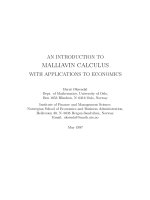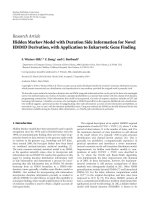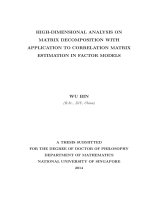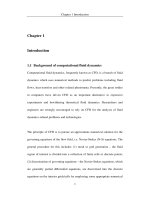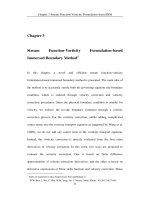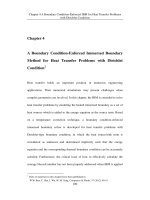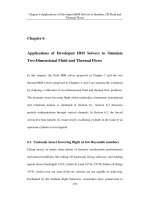Development of novel microextraction methods with application to environmental analysis
Bạn đang xem bản rút gọn của tài liệu. Xem và tải ngay bản đầy đủ của tài liệu tại đây (1.62 MB, 152 trang )
DEVELOPMENT OF NOVEL MICROEXTRACTION
METHODS WITH APPLICATION TO
ENVIRONMENTAL ANALYSIS
XIANMIN JIANG
NATIONAL UNIVERSITY OF SINGAPORE
2005
DEVELOPMENT OF NOVEL MICROEXTRACTION
METHODS WITH APPLICATION TO
ENVIRONMENTAL ANALYSIS
BY
XIANMIN JIANG
A THESIS SUBMITTED
FOR THE DEGREE OF
DOCTOR OF PHILOSOPHY
DEPARTMENT OF CHEMISTRY
NATIONAL UNIVERSITY OF SINGAPORE
2005
i
Acknowledgements
First of all, I would like to express my sincere thanks to my supervisor, Professor Lee
Hian Kee, for his important suggestions, guidance and encouragement during the course
my study.
Special thanks to Miss Frances Lim for her kindness and technical assistance.
I also express my thanks to my colleagues Dr. Gong Yinhan, Hou Li, Shen Gang, Tu
Chuan Hong, Zhu Liang, Zhu Lingyan, Chanbasha Basheer, Ms. Wen Xiujuan, Wu
Jingming, Mr. Zhang Jie for their kind advice and discussions.
I thank National University of Singapore for the research scholarship and financial
support during my study.
Last but not least, I am deeply grateful to my wife, Dr. Wu Wenxia, for her endless
understanding, concern, and support.
ii
Contents
Acknowledgements i
Contents ii
List of Abbreviations viii
Summary xi
Chapter 1 Introduction 1
1.1 Historical Development of Extraction Techniques 1
1.2 Recent Development of Microextraction Techniques 4
1.2.1 Two-phase microextraction 5
1.2.1.1 Solid-phase microextraction 5
1.2.1.2 Theory of solid-phase microextraction 6
1.2.1.3 Stir bar sorptive extraction 7
1.2.1.4 Theory of stir bar sorptive extraction 8
1.2.1.5 Liquid-liquid microextraction 9
1.2.1.5.1 Flow injection extraction 11
1.2.1.5.2 Single-drop microextraction 12
1.2.1.5.3 Hollow fiber-protected liquid phase microextraction
(LPME/HF) 15
1.2.1.5.4 Theory of liquid-liquid microextraction (LLME) 16
1.2.2 Three-phase microextraction 17
1.2.2.1 Headspace microextraction 17
1.2.2.2 Solvent microextraction with simultaneous back-extraction 19
iii
1.2.2.3 Liquid-liquid-liquid microextraction (LLLME) 20
1.2.2.4 Theory of liquid-liquid-liquid microextraction (LLLME) 22
1.3 General Objectives 25
1.4 References 26
Chapter 2 Development of a New Type of Fiber
(Siliceous ZSM-5 Coated Capillary Tube)
for Solid Phase Microextraction 31
2.1 Introduction 31
2.2 Experimental Section 33
2.2.1 Apparatus 33
2.2.2 Chemicals and materials 33
2.2.3 Preparation of ZSM-5 coated capillary tubing fiber 35
2.2.4 Extraction procedures. 36
2.3 Results and Discussion 37
2.3.1 Basic principle of ZSM-5 coating for SPME 37
2.3.2 Scanning electron microscopic images of ZSM-5 coated layer 41
2.3.3 Structure and sorptive properties of ZSM-5 44
2.3.4 Effect of extraction time 45
2.3.4 Repeatability and reproducibility 46
2.3.5 Linearity and limits of detection 47
2.3.6 Thermal stability 49
2.4 Concluding Remarks 50
2.5 Reference 51
iv
Chapter 3 Solvent Bar Microextraction 53
3.1 Introduction 53
3.2 Experimental Section 55
3.2.1 Apparatus 55
3.2.2 Chemicals and materials 56
3.2.3 Solvent bar microextraction 56
3.2.4 Single-drop microextraction 58
3.2.5 Static LPME/HF 58
3.2.6 Solid-phase microextraction 59
3.3 Results and Discussion 60
3.3.1 Theory for solvent bar microextraction 60
3.3.2 Characteristics of hollow fiber 64
3.3.3 Selection of organic solvent 64
3.3.4 Organic solvent volume 66
3.3.5 Effect of stirring speed. 67
3.3.6 Enrichment-factor comparison of single-drop LPME, LPME/HF and
SBME. 69
3.3.7 Extraction time profile 71
3.3.8 Reproducibility. 71
3.3.9 Linearity and limits of detection. 72
3.3.10 Analysis of slurry sample. 73
3.4 Concluding Remarks 75
3.5 References 76
v
Chapter 4 Application of Solvent Bar Microextraction
Combined with GC-MS of Polycyclic Aromatic
Hydrocarbons in Aqueous Sample 78
4.1 Introduction 78
4.2 Experimental Section 80
4.2.1 Chemicals and materials 80
4.2.2 Instrumentation 80
4.3 Results and Discussion 81
4.3.1. Mechanism of solvent bar microextraction (SBME) 81
4.3.2 Extraction time 83
4.3.3. Stirring speed 84
4.3.4. Salt effect on SBME 85
4.3.5. Enrichment factor comparison of SBME and static LPME/HF 86
4.3.6. Quantitative analyses 86
4.3.7 Real drinking water analysis 89
4.4 Concluding Remarks 90
4.5 Reference 91
Chapter 5 Dynamic Hollow Fiber-Supported
Headspace Liquid-Phase Microextraction 93
5.1 Introduction 93
5.2 Experimental Section 95
5.2.1 Apparatus 95
5.2.2 Chemicals and materials 96
vi
5.2.3 Preparation of soil sample 97
5.3 Results and Discussion 98
5.3.1 DHF-HS-LPME 98
5.3.2 Selection of organic solvent for DHF-HS-SME 101
5.3.3 Effect of dwell time 101
5.3.4 Water effect on DHF-HSME 102
5.3.5 Temperature effect on DHF-HS-LPME 104
5.3.6 Salt effect on DHF-HS-LPME 106
5.3.7 Quantitative analysis of DHF-HS-LPME 106
5.4 Concluding Remarks 109
5.5 References 110
CHAPTER 6 A New Dynamic Liquid-Liquid-Liquid
Microextraction With Automated
Movement of Acceptor Phase 112
6.1 Introduction 112
6.2 Experimental Section 114
6.2.1 Apparatus 114
6.2.2 Chemicals and materials 115
6.2.3 Extraction procedure 116
6.3 Results and Discussion 118
6.3.1 Basic mechanism 118
6.3.2 Selection of organic solvent 122
6.3.3 Compositions of the donor and acceptor phases 123
6.3.4 Extraction time 125
vii
6.3.5 Agitation 126
6.3.6 Plunger speed and dwell time 127
6.3.7 Method evaluation 129
6.3.8 Comparison with static liquid-liquid-liquid microextraction
(LLLME) 131
6.4 Concluding Remarks 133
6.5 References 134
Chapter 7 Conclusions 136
viii
List of abbreviations
Ace acenaphthene
Anth anthracene
ASP aqueous sample plug
AF aqueous film
CB chlorobenzene
CE capillary electrophoresis
DCB 1,2-dichlorobenzene
DCP 2,4-dichlorophenol
DNP 3,4-dinitrophenol
ECD electron capture detection
E
f
enrichment factor
FIE flow injection extraction
Flu fluorene
Fluo fluoranthene
GC gas chromatography
GC/ECD gas chromatography/electron capture detection
GC/MS gas chromatography/ mass spectrometry
HCB hexachlorobenzene
HF hollow fiber
HPLC high performance liquid chromatography
HS-SME headspace solvent microextraction
HS-LPME headspace liquid phase microextraction
HS-SPME headspace solid phase microextraction
ix
LC liquid chromatography
LLE liquid liquid extraction
LLME liquid liquid microextraction
LLLME liquid-liquid-liquid microextraction
LOD limit of detection
LPME liquid phase microextraction
LPME/HF hollow fiber-protected liquid phase microextraction
MAE microwave assisted extraction
3-NP 3-nitrophenol
4-NP 4-nitrophenol
OSF organic solvent film
PA polyacrylate
PAH polycyclic aromatic hydrocarbons
PCB pentachlorobenzene
PDMS polydimethylsiloxane
Phe phenanthrene
PTFE polytetrafluoroethylene
Pyr pyrene
r
2
square of correlation coefficient
RSD relative standard deviation
SBME solvent bar microextraction
SBSE stir bar sorptive extraction
SFE supercritical fluid extraction
SIM selected ion monitoring
Single-drop ME single-drop microextraction
x
SLE supported liquid membrane
SME solvent microextraction
SME/BE solvent microextraction with simultaneous back-
extraction
SPE solid phase extraction
SPME solid phase microextraction
TCB 1,2,3-trichlorobenzene
TECB 1,2,3,4-tetrachlorobenzene
VOCs volatile organic compounds
USEPA United States Environmental Protection Agency
xi
Summary
With the trend of miniaturization in analytical chemistry, microscale sample
pretreatment techniques have become an active research field because they have obvious
advantages of low cost, efficiency, selectivity, high enrichment and possible automation.
The potential of on-line coupling with chromatography is also possible.
This work focuses on the development of novel microextraction techniques and their
applications to environmental sample analysis. The new microextraction techniques
include developing a new type of fiber for SPME, solvent bar microextraction (SBME),
dynamic hollow fiber-supported headspace solvent microextraction (DHF-HS-SME), and
dynamic liquid-liquid-liquid microextraction with the automated movement of the
acceptor (final extracting) phase (LLLME/AMAP).
Firstly, a siliceous ZSM-5 (Si/Al > 50) coated capillary tubing as a new type of solid
phase microextraction (SPME) fiber was investigated. The selectivity of this coating for
SPME is due to its unique adsorptive characteristics. This new fiber was investigated for
the extraction of chlorobenzenes from the gaseous phase. The ZSM-5 adsorbent
represents a new, stable, and durable inorganic material that is hydrophobic for the SPME
of volatile organic compounds.
Secondly, another liquid-liquid microextraction technique, termed solvent bar
microextraction (SBME) was developed In this method, the organic extractant solvent (1-
octanol) was confined within a short length of a hollow fiber membrane (heat-sealed at
both ends) that was placed in a stirred aqueous sample solution. Tumbling of the
extraction device within the sample solution facilitated extraction. Since the hollow fiber
xii
membrane was sealed, it could be used for extraction from “dirty” samples, such as soil
slurries, etc. This novel microextraction method was compared with single-drop
microextraction and static hollow fiber membrane microextraction in which the extractant
solvent was also held within a hollow fiber but with the latter fixed to a syringe needle
(i.e. there was no tumbling effect). Comparison between SBME and conventional solid-
phase microextraction in a soil slurry sample was also investigated.
Thirdly, a dynamic hollow fiber-supported headspace solvent microextraction (DHF-
HS-SME) was developed. With the hollow fiber as support, the surface area afforded by
the organic phase was increased. Furthermore, with the movement of syringe plunger, a
very thin organic film was formed inside the hollow fiber. Analysis was carried out by
gas chromatography/mass spectrometry. The effect of sampling temperature, water, salt,
dwelling time were investigated. Results indicated that this novel headspace
microextraction method was a good alternative to conventional headspace extraction
method. The enrichment factor, linear range, the limits of detection and repeatability
were evaluated. This technique represents an inexpensive, convenient, fast and simple
sample preparation of semi-volatile organic compounds.
Finally, a new dynamic liquid-liquid-liquid microextraction procedure, with the
automated movement of the acceptor phase (LLLME/AMAP) to facilitate mass transfer,
was developed. In this method, the extraction involved filling a 2-cm length of hollow
fiber with 4 µL of acceptor solution using a conventional microsyringe, followed by
impregnation of the pores of the fiber wall with organic solvent. The fiber was then
immersed in an aqueous sample solution. The analytes in the sample solution were
extracted into the organic solvent, and then back extracted into the acceptor solution.
During extraction, the acceptor phase was repeatedly moved in and out of the hollow
fiber channel with the syringe plunger controlled by a syringe pump. The results
xiii
indicated that up to 400-fold enrichment of the analytes could be obtained under
optimized conditions. The enrichment factors were two times those of static liquid-liquid-
liquid microextraction. In addition, in contrast to previously reported dynamic three-
phase microextraction, this new method shows much higher extraction efficiency.
All the above-mentioned techniques are reported and described and the results
indicated that they could serve as alternative methods to conventional sample preparation.
These techniques are not only excellent preconcentration methods, but also effective
sample clean-up steps for environmental analysis.
1
Chapter 1
Introduction
1.1 Historical Development of Extraction Techniques
An analytical procedure particularly in the environmental area has several steps:
sampling, sample handling, sample preparation, separation and quantitation, statistical
evaluation, interpretation of results, and finally, necessary action. Among these steps,
sample preparation is one of the most important steps for obtaining correct and
accurate results of the appropriate quality [1].
A sample preparation is necessary to isolate the analytes from the sample matrix.
This step also includes “clean up” procedures for very “dirty” and complex samples.
In addition, the sample preparation can concentrate analytes and improve limits of
detection and sensitivity.
Despite advances in separation and quantitation techniques, many sample
preparation practices are based on traditional extraction techniques such as liquid-
liquid extraction (LLE), solid phase extraction (SPE), headspace extraction,
supercritical fluid extraction (SFE), microwave assisted extraction (MAE), etc.
LLE is among the oldest sample pretreatment method in analytical chemistry. In
LLE, hydrophobic sample analytes are extracted from aqueous phase with a water-
immiscible organic phase. Various volatile organic solvents can be used for extraction
such as acetone, chloroform, diethyl ether, hexane, methylene chloride, etc. For
successful LLE, the analyte should be extracted quantitatively from the sample into
the organic solvent. Usually, high extraction efficiency may be obtained by using
large volume of organic solvent and multiple extractions. After extraction, in order to
2
be suitable for injection into the modern analytical instrumentation such as gas
chromatography (GC), gas chromatography/mass spectrometry (GC/MS), capillary
electrophoresis (CE), high performance liquid chromatography (HPLC), the organic
solvent is normally evaporated to dryness and the residue is reconstituted by a small
volume of a appropriate solvent to ensure that the analytes are at detectable
concentrations. LLE is widely used in biological [2-6] and environmental samples [7-
9]. However, LLE has many disadvantages: it is cumbersome since evaporating the
organic solvent is necessary to preconcentrate the extract, and is time-consuming. In
addition, it requires a relatively large quantity of organic solvent that is usually
expensive, toxic and hazardous to the environment.
Solid phase extraction (SPE), also known as adsorbent extraction, is a process in
which analytes are extracted into a solid adsorbent after which the concentrated
analytes are eluted with a small quantity of organic solvent for instrument analysis.
The sorbents utilized for SPE are generally similar to the solid phase used in HPLC.
They include normal-phase, reversed-phase, size-exclusion, and ion-exchange
sorbents. SPE generally includes: (a) conditioning of solid phase; (b) eluting of the
unwanted components; (c) clean-up; (d) eluting the analytes of intent; (e) evaporation
of the organic solvent and concentration of the analytes. Alternatively, the unwanted
components may be retained at step (b) while the analytes are removed subsequently
from the sorbent. SPE can be applied to extract not only hydrophobic, but also more
hydrophilic compounds, which is an advantage over LLE. In addition, as compared
with LLE, SPE is faster and easier to manipulate, and provides higher enrichment
factors. The application of SPE to environmental analysis has made great progress in
the past two decades, and SPE has been introduced as standard method by the United
States Environmental Protection Agency (USEPA) [10]. However, SPE has some
3
significant limitations such as the ease with which the sorbent pores are blocked by
matrix, and a large volume elution volume. Furthermore, it may cause analyte loss
due to its multi-steps process. Finally, it is not suitable for extraction of volatile
compounds.
Conventional headspace analysis includes static headspace and dynamic purge-
and-trap techniques. In the static headspace approach, the objective is to seal the
sample in a gas-tight vial with a septum to sample the vapors within the vial. Analytes
are equilibrated between the sample and its headspace. After a prescribed extraction
time, the vapor is sampled with a microsyringe. Dynamic purge-and-trap is another
technique for volatile organic compounds (VOCs) analysis. Its sampling involves the
passing of a carrier gas through an aqueous sample to purge the VOCs from the
matrix, followed by the trapping of the analytes on a sorbent. The analytes are
subsequently desorbed into the analytical instrument. Usually, as with static
headspace sampling, dynamic purge and trap has been widely used to analyze VOCs
in environmental contaminants, clinical products, food, and aromas [11-15]. However,
static headspace suffers from low sensitivity due to the lack of a concentration effect.
For dynamic purge-and-trap, there are some disadvantages, including complicated
operation, foaming and cross-contamination in relation to the sorbent trap in particular.
Microwave-assisted extraction exploits electromagnetic radiation to desorb
analytes from their matrices, usually solids or semi-solids. The first application of
microwave-assisted extraction of analytes from a matrix was reported in 1986 [16].
The essential components of a microwave system include a microwave generator,
wave transmission, resonant and a power supply. The system utilizes the heating
effect by the microwave to drive the analytes in the matrix into the organic solvent.
After extraction, the organic solvent in excess is evaporated and the residue is
4
reconstituted with a small amount of an appropriate solvent. MAE has been widely
used in environmental analysis [17].
Supercritical fluid extraction (SFE) is a process that exploits the solvation power
of fluids at temperatures and pressures close to their critical point. The supercritical
fluid improves extraction efficiencies within shorter times as compared with other
conventional extraction methods. Under the critical point, supercritical fluid retains
the advantageous properties of a gas such as high diffusivity and low viscosity. In
addition, even the less volatile compounds can be separated from solid samples using
this method. However, SFE requires an expensive high-pressure carbon dioxide
delivery system.
To address the above problems of conventional extraction techniques, such as
large volume consumption, labour-intensive operations and cost, recent research
activities are oriented towards the development of convenient, efficient, economical,
and miniaturized sample preparation techniques. Although most of these techniques
are more suitable for aqueous matrices, they may be modified to handle solid or semi-
solid samples.
1.2 Recent Developments of Microextraction Techniques
In the past few decades, miniaturization has become an important trend in the
development of sample pretreatment techniques and has been developing very rapidly
in terms of its technology and applications.
Microextraction is defined as an extraction technique where the volume of
extracting phase is just very small in relation to the volume of the sample [18]. In
addition, the extraction is usually not an exhaustive but an equilibrium process.
Microextraction techniques are generally classified as two-phase microextraction and
5
6
Figure 1-1 Schematic diagram of classification of microextraction techniques
three-phase microextraction. Two-phase microextraction includes direct solid phase
microextraction (SPME), membrane-protected SPME and stir bar sorptive extraction
(SBSE), etc. Three-phase microextraction includes headspace microextraction and
liquid-liquid-liquid microextraction (LLLME). The detailed classification of these
microextraction techniques is shown in Figure 1-1.
1.2.1 Two-phase microextraction
1.2.1.1 Solid Phase Microextraction
In 1990, Arthur and Pawliszyn introduced the concept of solid phase
microextraction (SPME) [19]. Typically, SPME is based on the partitioning of the
analyte between the matrix and the polymer film coating (extracting phase), usually
immobilized on a fused silica substrate (fiber). The distribution ratios of analytes
between the sample and the coating are dependent on matrix effects which involve the
pH value, salt concentration, addition of organic solvents, agitation, and compounds
in excess due to competitive absorption.
A number of coatings have been investigated for their particular properties, such
as polydimethylsiloxane (PDMS) [20-25], liquid crystal polyacrylate (PA) [26-28],
Carbowax/divinylbenzene (CW/DVB) [29-31], Carbowax/templated resin (CW/TP)
[32-34], Carboxen/PDMS [35-37],
Divinylbenzene/carboxen/PDMS
(DVB/CAR/PDMS) [38].
In addition, some other coating materials, such as
polypyrrole [39], nafion [40], poly (3-methylthiophene) [41], crown ether by sol-gel
technology [42], bonded sol-gel layer [43], molecularly imprinted sol-gel materials
[44-45], polycrystalline graphite (pencil lead and glassy carbon) [46], and low-
7
temperature glassy carbon films [47], were developed to extract substances such as
metal ions, proteins, polar compounds, pesticides, volatile organic compounds, etc.
Among these coatings, the most widely used and reported is PDMS. It is a non-polar
extracting phase and has been utilized for the extraction of various volatile
compounds in environmental, industrial, pharmaceutical and clinical samples [48].
SPME is a solvent-free procedure that has the advantages of simplicity, high
sensitivity, easy automation, rapid preconcentration, and extraction ability. In contrast
with other conventional sample preparation techniques such as LLE, SPE, etc, It
combines the extraction, preconcentration, and sample introduction into one simple
solventless step. The initial utilization of SPME was in combination with GC analysis.
Later, interfacing with HPLC and CE was reported.
SPME is dependent on the partitioning of the analytes between the sample matrix
and the polymer coating. The thickness of the coating determines the volume and
surface area of the extracting phase, and consequently, the amount of adsorption on
the fiber. The active length of the coating is typically 1 cm. During extraction, the
SPME fiber is exposed to sample for a prescribed time and the target analytes are
extracted form the sample matrix into the coating. After sampling, the fiber is
retracted into the holder. It is then inserted into the GC injection port for thermal
desorption, followed by separation and analysis.
However, SPME suffers from some limitations. Its fiber is fragile and can easily
be broken. Care should be taken in handling the SPME fiber during sampling and
injection. Another problem is that the fiber has limited capacity and extraction is
strongly influenced when sampling complex liquid matrices. When a high
concentration of suspended matter is present in the sample, the fiber coating may be
damaged due to the excess absorption on the surface. Moreover, carry-over of the
8
fiber may be present for some analytes and in some cases it is difficult to eliminate it
even at high desorption temperature.
1.2.1.2 Theory of solid phase microextraction
At equilibrium, the amount of analyte absorbed by the coating is directly to its
concentration in the sample [49]
sffs
soffs
VVK
VCVK
n
+
= (1)
where n is the mass of an analyte absorbed by the coating;
f
V and
s
V are the
volumes of the coating and the sample, respectively;
fs
K is the partition coefficient of
the analyte between the coating and the sample matrix;
o
C is the initial concentration
of the analyte in the sample.
Usually, the coatings used in SPME have a high affinity for organic molecules,
hence the values of
fs
K are large. These large values of
fs
K lead to good
preconcentration of the target analytes in the aqueous sample and a corresponding
high sensitivity in terms of the analysis. However, it is unlikely that the values of
fs
K are large enough for exhaustive extraction of analytes from the sample. Therefore,
SPME is an equilibrium process, rather than an exhaustive one, but can be used to
accurately determine the concentration of target analytes in a sample matrix through
proper calibration strategies. As equation (1) indicates that if
ffss
VKV >> , the
amount of analyte extracted by the fiber coating could be simplified to
offs
CVKn =
9
and is not related to the sample volume. This feature makes SPME suitable for field
sampling and analysis in which it combines sampling, extraction, concentration, and
injection into a single process.
1.2.1.3 Stir Bar Sorptive Extraction
Although SPME is a simple and easy -operated technique, the detection limit of
SPME is limited by the small amount of PDMS. For the most common 100 µm
PDMS fiber, its coating volume is only 0.61 µL. This usually results in low extraction
efficiencies and requires very sensitive and selective detectors.
In 1999, some ten years after SPME was introduced, Baltussen et al [50] reported
a technique that used a stir bar coated with PDMS. The procedure was termed stir bar
sorptive extraction (SBSE). A stir bar was incorporated in a glass tube giving an outer
diameter of 1.2 mm and the assembly was coated with a layer of PDMS of 1 mm
thickness. The length of the stir bar can be varied from 10 mm to 40 mm,
correspondingly, providing amounts of PDMS ranging from 55 µL to 219 µL. The
coated stir bar is added to the aqueous sample for stirring and extraction. After a
prescribed time, it is removed from the solution and the analytes thermally desorbed
in a thermal desorption device. The desorbed analytes are then directed to GC or
GC/MS for analysis. The drawback of this technique is that it needs a special,
expensive (about S$60,000) and complex thermal desorption unit for the stirring bar.
1.2.1.4 Theory of SBSE
The theory of SBSE is similar to that of SPME [51], which is based on the
partition coefficients of analytes between the sample and the coated adsorbent. Since
we can approximate that the partition coefficient between PDMS and water
